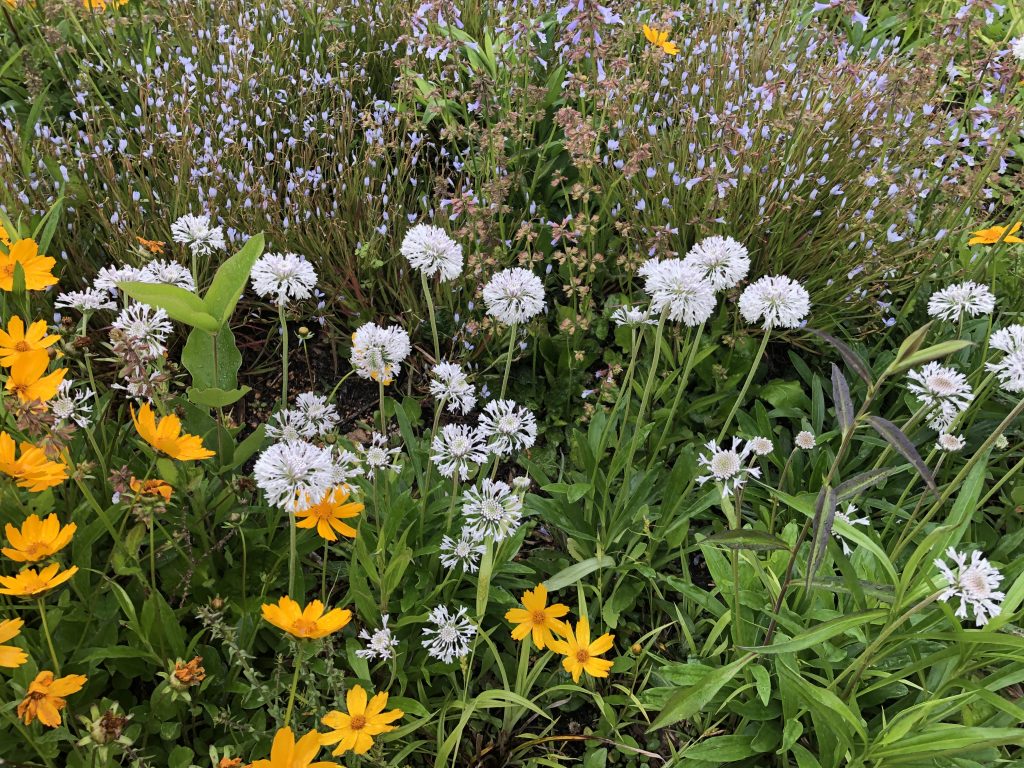Across North Carolina, wildflowers and other native plants grow beside highways, in fields and gardens, or wherever they can take root and astound us with their natural beauty. They give a sense of belonging as familiar blossoms sprout in the Coastal Plain, Piedmont, and Mountains. To draw the public’s eye to the importance of wildflowers and highlight the roles individuals, professionals, and groups can play in their conservation, the North Carolina Botanical Garden is pleased to announce that Governor Roy Cooper has proclaimed May 3–9, 2020 as North Carolina Wildflower Week. Click here to read the proclamation.
Wildflowers do much more than add beauty to the landscape. They help conserve water, reduce mowing costs, provide habitat for birds, butterflies and other wildlife, protect the soil and save money on fertilizer and pesticides.
Unfortunately, many of our wildflowers are in danger from invasive plants taking over their growing spaces and from urban expansion taking its toll on how many wildflowers sprout and survive. North Carolina Wildflower Week aims not only to highlight the beauty of our wildflowers, but to also encourage citizens to take steps to conserve and protect them.
Families and individuals can find several ways to celebrate the week in their area. Whether you take a hike at a local natural area, donate to support plant conservation or start your own wildflower garden, anyone can support and observe North Carolina Wildflower Week.
Staff Wildflower Favorites
We’re excited to share some of our favorite wildflowers with you in this short video series. Watch the first video below, and check back later this week for more!
Ten Ways to Observe North Carolina Wildflower Week
1. Do some research
You don’t even have to leave the comfort of your own home. Get on the internet and look at wildflowers native to your area, region and state. Identify which wildflowers grow in your backyard or neighborhood. Do you know the official state wildflower of North Carolina? (Hint: It’s not the dogwood!)
2. Take a local hike
Even a short hike can open your eyes to the wide world of wildflowers. Find a field with a large wildflower population and take a slow walk through. Take along your copy of Wildflowers of the Atlantic Southeast to identify the plants you see.
3. Visit a park or natural area
Spend an afternoon wildflower hunting in a park or natural area. Even though our display garden is closed, our nature trails and preserves remain open, including the Piedmont Nature Trails, Battle Park, Mason Farm Biological Reserve, Parker Preserve, and Penny’s Bend Nature Preserve. Learn more.
4. Be a photographer
Even if you’ve never been a professional picture-taker, grab your camera and snap some photos of wildflowers around you – you might find you have a knack for capturing a still life or the beauty of nature – and you’ll have lasting memories of the blooms that year. And remember, “pics” are better than “picks” – a photo lets you and someone else enjoy the flower, rather than picking it only for your enjoyment. Once you’ve taken your pictures, submit them to our Community Photo Exhibit!
5. Donate your time, talent and treasure
Nature centers, gardens and parks depend on volunteers and donations to help with maintenance and other costs.
6. Pick up a book
Not an outdoor type? Not to worry, even bookworms can participate in North Carolina Wildflower Week. Find a book and read up on wildflowers and their benefits. We have a curated list of recommended reading posted here.
7. Start a garden
Whether you renovate your backyard or just plant some seeds in a small pot, making your own wildflower garden is a great way to celebrate native wildflowers. A perfect project for any age, find out what size garden works best for you, and pick out wildflowers that will grow well in your environment. Native gardening can help preserve a sense of regional identity and native plants typically work well with area soils. Click here for tips on how to start a wildflower garden.
8. Look up endangered wildflowers
Despite conservation efforts, wildflowers in every state are still endangered or threatened by urban development and habitat loss. Check out which plants in North Carolina are in danger and what you can do to help by visiting the Friends of Plant Conservation.
9. Be conservation-conscious
With so many threats to the environment, wildflowers and all plant and animal life is being affected. To celebrate North Carolina Wildflower Week and take your commitment beyond this week, look at what you can do to be more environmentally-friendly. Some examples include considering taking mass transit or a bike to school or work, reducing your energy bills at home or using organic products. Keep looking forward, and make sure there will still be wildflowers and other plants to enjoy for years to come.
10. Spread awareness
Tell your friends, family, neighbors and others about native wildflowers and their importance to the natural landscape. Encourage them to get involved with North Carolina Wildflower Week in their own ways. Use #NCWildflowerWeek to share your photos and experiences with us on social media!
